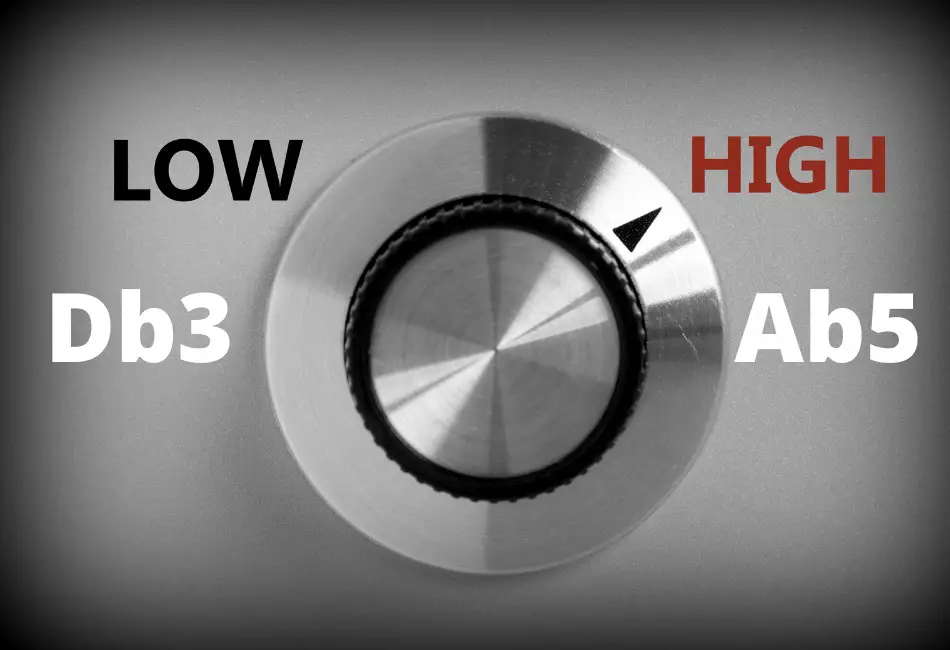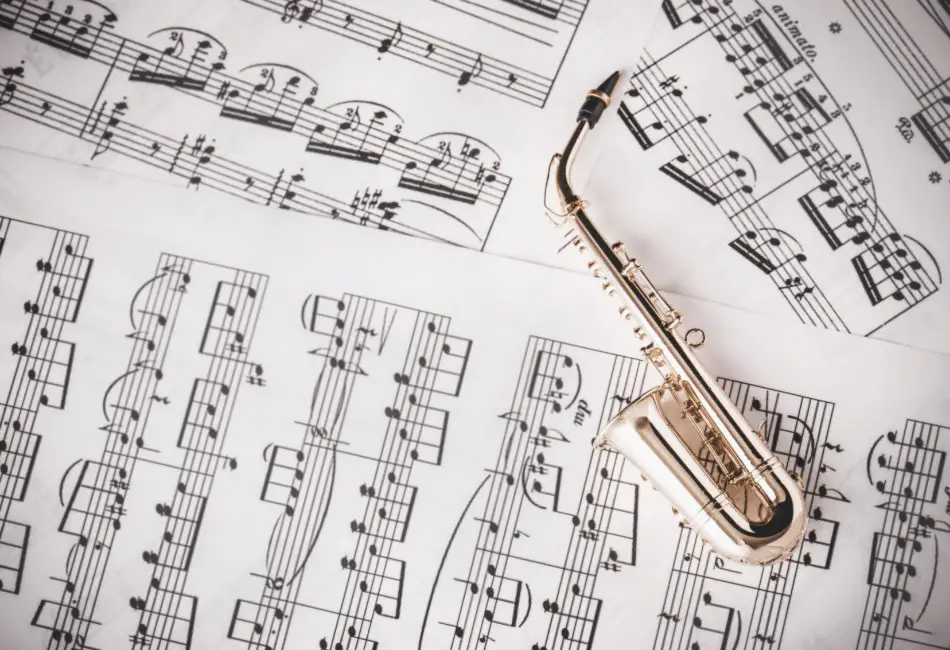Are you wondering how high and low the alto sax plays?
Do you want to make sure your music is in the range of the alto sax?
Whether you’re a music student, composer, arranger, or sax enthusiast, knowing the range of the instrument is just good.
You don’t want to assume it can play something it can’t. I’ve made that mistake when arranging music for band groups.
We’ve got you covered here today with a discussion on this topic, so you don’t make the same mistakes I do.
Table of Contents
What Is The Range Of The Alto Sax?
The alto saxophone’s range is from concert pitches Db3 (otherwise known as the Db below middle C) to Ab5. This gives the alto a range of 2 octaves and a Major Fifth. If the alto has a high F# key, this extends the range to A5.
The functional written pitch of the alto saxophone is Bb3 to F6 (F#6 with the high F# key).
When it comes to the written pitch of the saxophone, remember this is an Eb instrument. This means, when they see a C, the note they play is the Eb.
In other words, the written pitch is always down a minor third from the sounding pitch. Opposite of this, the concert or sounding pitch is a minor third higher than the written pitch.
If an alto plays their G major scale, they play a Bb major scale in sounding pitch.
Confusing, right? This is for two reasons.
First, it always helps the written music to appear within the staff.
When you play high or low, you don’t want the music to go so high and low all you do is read ledger lines way off where the music normally is.
It’s much harder to read.
The common transposing also makes it, so the fingering for the written notes stays the same across all saxophones despite the different registers.
This means an alto player can pick up any member of the saxophone family and still be able to read and finger easily despite the differences.
This is similar reasoning to why the clarinet is a transposing instrument.
If you know a sax player (or want to put a bug in a loved one’s ear), check out these best gifts for saxophone players we collected to help you show you care.
How Many Octaves Does Alto Sax Have?
If we assume the standard range of Db3 to Ab5, it’s easy to figure out how many octaves there are.
First, we go up two octaves from the lowest pitch, taking the Db3 to Db4 and then Db5.
Now, we need to figure out from Db5 to Ab5. This is a major fifth.
Therefore, we see the alto has a functional register of two octaves and a major fifth.
Of course, this is only the standard range. Professional-level alto saxophone players can learn and master a technique called altissimo.
This is a challenging technique most players will never even think about using.
At the top of the standard range (Ab5 or written F6), we run out of the standard fingerings.
Altissimo uses a combination of unusual fingerings, reed changes, air control, mouthpiece manipulation, and mouth shape to reach the overtones of the pitches.
This is a fancy way of saying high, whistling, “ghosty” high notes.
With this technique, there is theoretically no limit to how high it can play (similar to brass instruments), but for most people, this adds one to two octaves on top of the two and a fifth octaves before.
This usually isn’t a consideration for 95% of alto saxophone players, but it is something to be aware of.
All members of the saxophone family may use this technique.
Of course, no amount of skill or fancy techniques will overcome a crappy saxophone.
Avoid this problem by picking from the best saxophone brands when shopping (check out our article for more details).
What Is The Frequency Range Of The Alto Saxophone?
The alto saxophone’s typical frequency range is 138-830 (880) Hz.
The frequency range is the scientific measurement of the number of vibrations in the sound.
This is typically measured in hertz or Hz.
This measures how many times the sound wave cycles in one second.
For this answer, I looked at the standard range of the alto, excluding the advanced altissimo techniques.
All altos have the lowest note of Db3, which comes out to 138 Hz.
Many alto saxes top out at Ab5, which comes to 830 Hz.
The F# key is added for more advanced saxophones, which allows the A5 pitch (written as F#6). This has a frequency of 880 Hz.
Fun fact: Many musicians have heard of the standard tuning of A4 = 440 Hz. Every time you go up one octave, you double the Hz. This is why A5 = 880 Hz.
To go lower, we cut the frequency in half. Therefore, A3 is half of 440 Hz, making it 220 Hz.

How Do I Learn More Notes On The Alto Sax?
I love answering questions like this. As a music teacher, I’ve spent my career helping people find the right ways to learn new things, especially instruments.
There are a few ways you may want to consider.
The first one I’d recommend is finding a private lesson teacher. They will help guide you on your path.
This being said, private lessons get expensive. If you already have some experience and want to get better, you have two main choices.
First, join a band with other saxophone players. Playing the music and playing along with others (some of whom may be better than you) will naturally help you play better.
Second, take some online learning in hand. Or better yet, do all three or some combination.
If you’re looking for some affordable and reliable online saxophone courses, I do enjoy what Udemy offers. Many of them are great, but the course at the link below is the overall best, in my opinion.
Affiliate disclaimer.
This one is considered the best rated on the platform, and even though it’s meant for “beginners,” there’s a lot there for anyone.
This course is for the alto and not the tenor saxophone or the baritone saxophone. Check out the link, though, for options on those instruments.
Final Thoughts
I hope this helped you look at the range of the alto sax in a little different way.
I love the sound and range of the alto, and many others do as well!
It’s remained one of the most popular wind instruments since its invention, and part of the reason is the mellow and pleasant register.
Now enjoy some sax playing!

